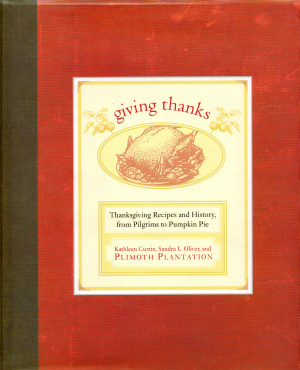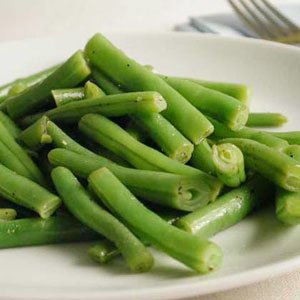A second annual selection of Thanksgiving recipes inspired by Giving Thanks.
In our first Thanksgiving Number, our twelfth overall, we included an Appreciation of Plimoth Plantation and James Deetz that in turn included what amounts to an appreciation of Giving Thanks, the history of Thanksgiving and its recipes by Kathleen Curtin and Sandra Oliver. The book was first published in New York during 2005. We described it then as erudite yet accessible, and nothing has caused us to change our minds.

Number 20 also included two recipes based on versions that appear in Giving Thanks. It would seem altogether fitting, as the creator of official Thanksgiving once said following a ghastly battle somewhere in Pennsylvania, to continue, or rather create, the annual tradition. We have chosen two dishes with undeniably British antecedents and a third that is the pride of Camden, New Jersey, or what is left of the place.
The three recipes would make a good dinner amongst themselves; the two vegetable dishes also make good sides for the Thanksgiving turkey and its other trimmings. As usual at britishfoodinamerica, annotations to each recipe may or may not divert the assiduous reader with educational and entertaining insights.
Duck with cranberries. This is derived from a seventeenth century recipe that uses a remarkably twenty-first century technique in both braising the duck on the stove and then searing it in a hot oven. We like the eighteenth century English recipes for boiled duck but miss the crispy skin; this throwback from before the Enlightenment demonstrates that at least some Restoration cooks had seen a light.
The Duck:
 -a duck
-a duck
-about 1½ teaspoons salt
-2 bay leaves
-a peeled and quartered onion
-some dozen stalks of parsley
-about a dozen whole peppercorns
-2 big sweet onions peeled and sliced into thin crescents
-another teaspoon salt
-1 teaspoon pepper
Its sauce:
-1½ cups red wine
-½ cup tawny Port
-1 heaped teaspoon minced ginger
-scant ½ teaspoon mace
-about ½ cup chopped parsley
-¼ cup chopped raisins
-¼ cup coarsely chopped cranberries
-4 Tablespoons cold unsalted butter cut into about 16 chunks
- Put the duck, salt, bay, quartered onion, parsley, and peppercorns in a pot barely big enough to hold them.
- Add enough water to barely cover the breast of the duck, bring to a boil, reduce the heat to a simmer, skim away any scum and cook the duck for about 45 minutes.
Preheat the oven to 425°. - Scatter the sliced onions over a shallow roasting pan just big enough to hold the duck.
- Fish the duck from its stock, season it with the teaspoons of salt and pepper and plop it onto the onions in the roasting plan.
- Roast the duck until the skin crisps, usually for about 20 minutes, then remove it from the oven, put it on a cutting board with a ridged border and tent it with foil. Let it rest for at least15 minutes, no less.
- Make the sauce by straining about a cup of the duck stock into a saucepan with the roasted onion crescents and the wine, Port, ginger, mace, parsley and raisins.
- Boil the mixture hard until it reduces by about two thirds, to a syrupy consistency.
- Carve the duck by removing the legs and cutting each breast in two across the breastbone.
- Add the juices that leaked from the duck onto the cutting board to the boiling sauce, give it a good stir, dump in the cranberries and continue cooking for about a minute.
- Whisk the butter into the sauce until it obtains a silken sheen and serve it with the duck.
Notes:
- The recipe in Giving Thanks calls for different cooking times and proportions, and uses the more assertive ground ginger and some sugar with the red wine instead of a portion of Port. This way is better.
- Giving Thanks provides a transcript of the original recipe from 1615. It appeared in The Newe Booke of Cookerie by John Murrell. It calls for burberries, which were not available to seventeenth century New England settlers, instead of cranberries, which were plentiful in both seventeenth century England and New England:
“To Boil A wilde Duck. Trusse and parboyle it, and then halfe roast it, then carve it and save the gravey: take the store of Onyons, Parsley, sliced Ginger, and Pepper: put the gravie into a Pipkin with washt currins, large Mace, Barberryes, a quart of Claret Wine: let it all boyle well together, scumme it cleane, put in butter and Sugar.”
- Our use of minced ginger is closer to the original recipe, and would provide a considerably more subtle tone to the sauce.
- If you can get dried currants instead of raisins, use them. They too are the subtler alternative. They are tiny and need not be chopped.
- Blueberries are a pleasant, but sweeter, alternative to the cranberries.
Mashed potatoes and turnips are excellent foil for the duck, in their own right and to soak up the juices and sauce. They have the added advantage of simplicity. For four; may be doubled, tripled or more.

-1 lb peeled Maine, Idaho or other floury potatoes, cut into 1 inch chunks
-1 lb peeled yellow turnips, also cut into 1 inch chunks
-2 Tablespoons unsalted butter
-about ¼ cup heavy cream
- Boil the potatoes and turnips separately in lots of salted water until tender.
- Drain them with utmost ruthlessness.
- Combine the potatoes, mash them up over low heat, add the cream until it begins to bubble, stirring the mash so it does not scorch, and add the butter with salt and pepper. The Mash is ready when the butter has melted: Ensure that everything is mixed well.
Notes:
- The dish bears an obvious debt to the ancient Scottish clapshot or ‘tatties and neeps,’ traditional mates for haggis. The principal difference in the original recipe, from The New England Economical Housekeeper by Mrs. E. A. Howland (Worcester, Massachusetts, 1845), is the substitution of cream, so beloved of early New Englanders, for the butter that the Scots would have used if they were prosperous enough to afford it, by no means a foregone conclusion.
- Mrs. Howland’s recipe does not include any butter.
- If yellow turnips scare you, and they should not, use the milder, slightly gingery white ones instead. They are, however, more watery.
- You can manage a big dinner party or holiday feast by boiling the vegetables in advance until not quite soft and leaving them in their water with a cover. When you are ready to serve your duck or other selection, like a Thanksgiving turkey, return the vegetables to a boil, turn them off, proceed to Step 2 and finish the dish.
A cold war casserole of canned green beans that sounds bad and tastes good. A considerable amount of lore surrounds this recipe. According to Giving Thanks, the dish remained a Thanksgiving staple for over twenty million Americans in 2005. It never appeared at table on Thanksgiving in any of the Editors childhood gatherings, but always appeared on Christmas day, when its ease of preparation attracted it to overtired parents grateful for any shortcuts after a frantic morning of presents and their attendant hysteria. We all loved it, even the children who hated vegetables, possibly because the constituent processed ones bear little resemblance to the fresh thing. If you do not use canned green beans, and they must be ‘French cut,’ then it is emphatically inauthentic. In fact, nothing should be fresh, not even frozen let alone organic or artisanal.

-1 can Campbell’s condensed cream of mushroom soup
-½ cup milk
-generous teaspoon (go ahead and use 2) Worcestershire
-about ½ teaspoon or more black pepper
-2 cans ‘French cut’ green beans
-1 16 oz can sliced mushrooms (never fresh) or the equivalent from smaller cans
-a 2.8 oz ‘can’ (it really is a cardboard cylinder fitted with metal top and bottom) French’s ‘fried onions’
Preheat the oven to 350°.
- Stir the soup, milk, Worcestershire and pepper together until married.
- Add the beans, mushrooms and half of the onions.
- Spoon the mixture into a quart and a half ovenproof dish and bake it until bubbly, usually about 25 minutes.
- Spread the rest of the onions over the top of the casserole and bake until they turn brown, usually in about another 10 minutes.
Notes:
- Soy sauce may be even more ‘authentic’ than Worcestershire; it was considered exotic.
- Do not, ever, think of adding salt. All the canned products embed so much sodium that your blood pressure could launch a rocket.
- The addition of the canned mushrooms apparently is an innovation by the Editor’s mother, and a good one.
- More lore, from Giving Thanks: The home ec. staffers at the Campbell’s Soup company created the basic recipe in 1955,
“and it has been Campbell’s most requested recipe ever since. French’s Fried Onions… had been available since 1933, but sales didn’t really take off until they were made famous as an ingredient and topping for the recipe. According to French’s, 50 percent of their Fried Onions sales occur at Thanksgiving, Christmas, and Easter.” (Giving Thanks 136)
Unintended synergy, before the term even applied to marketing.
- This is an appealing recipe, if only once in a while. Really.

